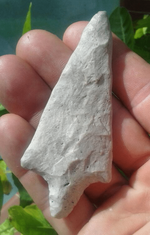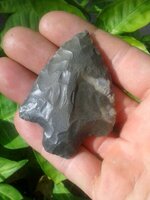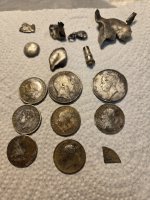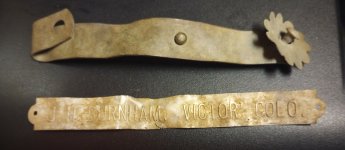You are using an out of date browser. It may not display this or other websites correctly.
You should upgrade or use an alternative browser.
You should upgrade or use an alternative browser.
Quick question about identifying.
- Thread starter -=METAL=-
- Start date
GatorBoy
Gold Member
- May 28, 2012
- 14,716
- 6,149
- Primary Interest:
- All Treasure Hunting
It matters alot.. Different point types are associated with different areas and the lithic material from that area. Material from outside of the area.. Buy a large distance just wouldn't be what was used to make that type.
Also point types in different areas are often seen made of one type of material over another as if the people from that area of that time preferred one material for a certain point
You won't see a Newnan found in Florida made of obsidian
Also point types in different areas are often seen made of one type of material over another as if the people from that area of that time preferred one material for a certain point
You won't see a Newnan found in Florida made of obsidian
Last edited:
monsterrack
Silver Member
- Apr 15, 2013
- 4,419
- 5,815
- Detector(s) used
- Garrett, and Whites
- Primary Interest:
- All Treasure Hunting
Like Gator said if the stone does not fit the area then you have to question the artifact, but anything is possible but just not likely. If you can find it the book Story in Stone by D.C. Waldorf will teach you a lot about types of points and the stone that they are made from for the area.
quito
Silver Member
Prized material found it's way along many trade routes. Lots of things are possible.
The KRF St. Charles Point found here in South Dakota that I recently picked up for example. Material was ok for the area, but the type is out of place. It just shows that people as well as their materials probably got around pretty good.... That Native from back east maybe shared a little of his technology for some of that great material, and hauled a lot of it back home. Who knows for sure.
The KRF St. Charles Point found here in South Dakota that I recently picked up for example. Material was ok for the area, but the type is out of place. It just shows that people as well as their materials probably got around pretty good.... That Native from back east maybe shared a little of his technology for some of that great material, and hauled a lot of it back home. Who knows for sure.
rock
Gold Member
I have found all different types of stone artifacts here. I have yet to find anything in green though. Red is rare also. If you are near a river that flows through many states anything is possible. The areas I hunt here there was quite a bit of trading with the Indians in this area from all over. It really helps to see and know what modern made rock looks like in your area.
Jon Stewart
Bronze Member
- Jan 11, 2011
- 1,029
- 931
Not all rock can be knapped.
GatorBoy
Gold Member
- May 28, 2012
- 14,716
- 6,149
- Primary Interest:
- All Treasure Hunting
Probably 90 percent of the stone tools are going to be made from the stone in the local area unless it happens to be an area with very little lithic material even then the stone will normally come from the same basic area.. As pointed out above there are exceptions but if you're going to go by probability I would definitely look at the local material.
-=METAL=-
Sr. Member
- Sep 13, 2013
- 294
- 183
- Detector(s) used
- Minelab E-Trac, Fisher F2
- Primary Interest:
- All Treasure Hunting
- Thread starter
- #9
What if you have two similar types of points from the same area, lets say a northeastern genesee, and a neville. The overstreet book says felsite for the neville, and shale for the genesee. Will the point made out of shale be a genesee because it is made out of shale? What if it is a dead ringer for the neville but made out of shale? Does it have to be made out of felsite to be classified as a neville? Does anyone get what I'm saying?
GatorBoy
Gold Member
- May 28, 2012
- 14,716
- 6,149
- Primary Interest:
- All Treasure Hunting
I get what you're saying and I wish it were that simple.
No the same point is not always made of the same material.
Some points in certain areas are more often made of a type of material in that area but its not 100 percent
No the same point is not always made of the same material.
Some points in certain areas are more often made of a type of material in that area but its not 100 percent
rock
Gold Member
GB is correct they could be made out of any type. It just depends on what stone was around at the time. They did prefer flint over most anything but would use whatever they could find if flint was scarce.
GatorBoy
Gold Member
- May 28, 2012
- 14,716
- 6,149
- Primary Interest:
- All Treasure Hunting
Shape and flaking style of the base is the most identifiable portion as the blade changes from resharpening.
It's an intricate and pretty complicated subject that takes alot of "evidence" into account besides basic shape.
Typology is what you would want to study
It's an intricate and pretty complicated subject that takes alot of "evidence" into account besides basic shape.
Typology is what you would want to study
Users who are viewing this thread
Total: 2 (members: 0, guests: 2)







